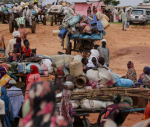You are here
Aspects of sustainable development
Jan 29,2024 - Last updated at Jan 29,2024
Sustainable development is concerned with answering the question: What do we do to ensure that the human race maintains an acceptable comfort, happiness, health and psychological state for as long as possible?
In order to answer the question, we must take into account the state of the environment in all its fields: natural, artificial, economic, social, cultural, health, psychological, aesthetic and others, in addition to managing natural resources to provide the minimum level of comfort and luxury required for a human being to live as a human being.
Scientists have conflicting expectations about the extinction of the human race before the end of the third millennium; optimists among them seek advanced awareness of the dangers facing us to avoid this catastrophe. Firstly, by realising the anthropogenic causes of pollution on this planet. Secondly, through obtaining sufficient scientific knowledge about pollution, global warming and climate warming. Thirdly, by adopting ethical stances regarding the local and global environment, and developing a sense of belonging to one planet and moving towards global peace instead of destructive wars as that which we witness today in Palestine and the Ukraine. Fourthly, by launching systematic awareness campaigns.
The 1987 report of the United Nations Commission on Environment and Development initiated the concept of sustainable development to take on dimensions that include conscious management of available natural resources to meet the needs of future generations, rehabilitation of the deteriorating environment and attempts to change the quality of growth. Targeting reasonable economic growth, addressing poverty problems, and meeting basic human needs in a way that achieves a balance between economic growth and the requirements of environmental protection, through developing production methods and using environmentally friendly technologies.
Ensuring sustainability is achieved through the ability to withstand and adapt to climate change by creating various means, such as creating resilient infrastructure, reducing disaster risks, and resisting extreme weather phenomena. The Netherlands, known for its innovative flood control systems, is a model in this regard.
Integrating sustainability principles into education systems provides future generations with the knowledge and skills needed to address environmental challenges. Reducing inequality is essential for achieving sustainable development and citizen happiness. Countries like Bhutan prioritise Gross National Happiness as a comprehensive measure of well-being, and emphasize not only economic growth, but also social harmony and cultural preservation.
Accordingly, sustainable development is a comprehensive approach whose goal is to improve the quality of life for all while ensuring the well-being of future generations. Practical examples of actions that lead to sustainable development span across different sectors and can be observed at different levels, from local communities to national and global initiatives. For example, switching from fossil fuels to renewable energy sources, such as solar energy, wind energy and hydroelectric energy, is an important step towards sustainable development. Many European countries, as well as countries in South America, have made significant investments in renewable energy infrastructure and have set ambitious targets to reduce greenhouse gas emissions.
Access to clean and affordable energy is an essential aspect of sustainable development. Initiatives such as the UN’s “Sustainable Energy for All” campaign aims to provide electricity and clean cooking solutions for people in developing regions. The “He for She” campaign, launched by UN Women, also calls for gender equality and women’s empowerment because achieving gender equality is essential for sustainable development.
Implementing sustainable agricultural practices can also improve food security, protect the environment and strengthen rural economies. It includes organic farming, crop rotation and agroforestry, which improve soil health and reduce the need for chemical inputs. Agroforestry is a sustainable land use system that combines crop cultivation, animal husbandry and tree or forest management in a way that benefits both parties, conserving biodiversity, improving soil quality, etc.
Protecting forests and participating in reforestation efforts is crucial to achieving sustainable development. Initiatives such as the Bonn Challenge aim to restore millions of hectares of forested land around the world. Also, effective management of water resources is essential for achieving sustainable development.
Developing sustainable cities includes designing urban spaces that reduce environmental impact and enhance the quality of life of residents. Cities such as Copenhagen, Denmark, are providing green spaces to promote sustainable urban living. Global health programs, such as those aimed at eliminating diseases such as polio and malaria, also contribute to the well-being of communities around the world. The Global Vaccine Alliance helps ensure that children in low-income countries are immunised against diseases.
Encouraging responsible consumption and production in a green economy involves reducing waste, recycling and adopting sustainable manufacturing practices. An example is the Zero Waste movement in San Francisco, which focuses on reducing waste and diverting it from landfills to a circular economy.
Finally, providing access to microfinance and supporting entrepreneurship can economically empower individuals and communities. Organisations, for example, Grameen Bank in Bangladesh, have been instrumental in promoting microcredit.














Add new comment